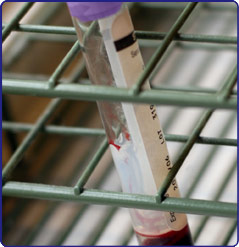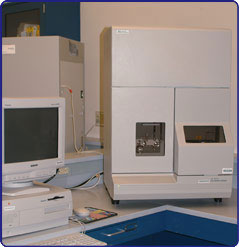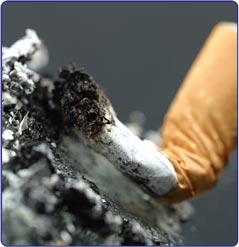Laboratory Analysis
The individuals tasked with investigating the case study crime were fortunate to identify and collect samples and evidence which, after testing, proved critical to identifying (and ruling out) suspects. Cigarette butts, pubic hair, blood samples, even the screwdriver itself, were examined and tested within the controlled setting of the forensic DNA laboratory.
Evidence Handling

Forensic DNA laboratories follow a set of procedures when evidence arrives for testing and analysis. The procedures consist of these main steps:
- Evidence screening
- DNA extraction
- DNA quantitation
- STR amplification
- STR characterization
- Analysis and interpretation
As a defense attorney, a prosecutor or a judge, it is important to know about these steps. If they are not conducted properly and completely, the evidence may lose value and relevance.
Evidence Screening

The first step performed in the laboratory is the screening of the evidence. The evidence is inventoried, documented and evaluated to determine if biological evidence is present. Once stains or other biological material of interest are located, they may be subjected to testing in an attempt to identify the type of biological material present, such as blood or semen.
For example, the cigarette butts collected from the case study crime scene will be delivered to the laboratory, cataloged and tested to determine if saliva is present.
DNA Extraction

The second step is referred to as DNA extraction. DNA extraction is the process of separating DNA from other cellular material contained in the recovered biological evidence. This is one of the most labor-intensive procedures of DNA analysis. The DNA extraction process requires careful handling of biological material to prevent sample contamination.
For example, the screwdriver handle in this case study may contain DNA in the form of skin cells. Although not visible to the naked eye, this DNA evidence can have a significant impact on the case.
DNA Quantitation

The third step is referred to as DNA quantitation. When using nuclear STR DNA analysis methods, and in order to comply with the National Quality Assurance Standards, the presence or absence of detectable human DNA contained in an evidentiary sample must be assessed. It is important to know the quantity of DNA extracted from a sample. If too much DNA is amplified, it could lead to complications with interpretation. If too little DNA is amplified, a partial DNA profile or, in extreme cases, no profile could result.
As in this cold case study, quantitation is especially important in cases where degradation might be a factor.
STR Amplification

The fourth step is referred to as STR amplification. During this step, duplicate copies of specific DNA target regions from the original sample are created. The STR amplification process also incorporates chemical labels that aid in the STR characterization step.
The amplification procedure involves heating and cooling samples in a specific pattern in an instrument called a thermal cycler. After approximately 30 cycles, a 'polymerase chain reaction (PCR) product' (amplicon or amplified product) is created and subsequently tested.
DNA Characterization

During the fifth step, DNA characterization is conducted by automated equipment that "reads" the exact order or "sequence" of base pairs contained in the DNA sample being analyzed. This characterization or "sequencing" process generates DNA identification data that can then be interpreted by the analyst.
DNA Analysis and Interpretation

In the sixth and final step, a DNA analyst will interpret the data. The result of the data interpretation will be a DNA profile (single source) or a combination of DNA profiles (multiple contributors). Every laboratory has its own standard operating procedures (SOP) for the interpretation, technical review and reporting of DNA data. The National Quality Assurance Standards require a secondary review of all DNA data to be entered into CODIS. Reporting formats vary. For example, some laboratories report an interpretive statement on their DNA analysis reports while others include statistical statements. Because the final report is presented in court proceedings, it is critical to understand an individual laboratory's SOP as it relates to forensic DNA analysis and interpretation.
Quality Assurance

The results of DNA testing can affect not only the criminal investigation, but the pretrial and trial proceedings. It is also important to recognize the impact that DNA results can have on the victim, the victim's family, and the accused. Quality assurance is a critical component of a forensic DNA laboratory's operating procedures.
To ensure quality in convicted offender and forensic DNA sample analysis, the FBI Director issued the "Quality Assurance Standards for DNA Testing Laboratories." These standards define requirements that must be met by any laboratory conducting DNA testing that wishes to participate in the NDIS or wishes to apply for federal funding.
Accreditation
Forensic DNA laboratories can become accredited, which demonstrates their compliance with the National Quality Assurance Standards. Additionally, in order to be in compliance with the National Quality Assurance Standards, laboratories conducting DNA analysis are required to participate in proficiency tests. A DNA proficiency test uses biological samples to assess an individual laboratory analyst's competency. The results of proficiency tests can be made available for court proceedings. The American Society of Crime Laboratory Directors - Laboratory Accreditation Board (ASCLD-LAB) and Forensic Quality Services-International (FQS-I) are two bodies within the U.S. that accredit forensic DNA laboratories.
Proficiency Tests

A DNA proficiency test uses biological samples to assess a laboratory analyst's ongoing competency and the laboratory's ability to produce accurate results.
There are different types of proficiency tests:
- An external test is created and administered by an outside agency
- An internal test is created and administered by the laboratory itself
- A blind test is given when an analyst does not know that they are being tested
Quality Control Samples

In addition to ensuring the competency of individual analysts, a critical component of a quality program includes the use of Quality Control (QC) samples. QC samples, also referred to as "standards," are analyzed with each batch of forensic samples to ensure that equipment is operating properly and that no inadvertent contamination occurred. Certified reference materials, whose composition is certified to a national standard, are often used as QC samples. Details regarding a laboratory's use of QC samples are also available from the laboratory for the purpose of court proceedings.
Types of Testing

Not all laboratories conduct the same DNA testing. Most DNA laboratories conduct STR testing on nuclear DNA, which is the single copy of DNA that exists in every cell nucleus. A select few laboratories specialize in Y-STR testing, which is the DNA analysis conducted on the Y-chromosome found only in males.
Other laboratories specialize in testing mitochondrial DNA (or mtDNA), which is found in every cell of the body regardless of the presence of a nucleus.
Testing on Case Study Evidence

Nuclear STR DNA analysis and mtDNA analysis were both conducted in evidence related to this case study. Nuclear DNA analysis was performed on the screwdriver handle and end, cigarette butts and the vaginal swab. These were compared to known reference samples collected from Sandy Doe (the victim), Lucy Johnson, Carol Johnson and Joe Smith (suspect). MtDNA testing was performed on pubic hair recovered from the victim's body at the time of autopsy. The CODIS hit, in addition to the results of all of these tests, played critical roles in the filing of charges for the rape and murder of Sandy Doe.


